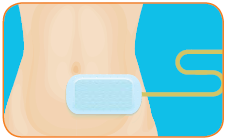Peritoneal Dialysis (PD / Water Dialysis)
Features
- A daily home-based treatment.
- Can be done by yourself or your caregivers.
Getting started

This picture shows the access point and catheter required for Peritoneal Dialysis (PD).
- A small, soft plastic tube (called a catheter) will be inserted into your belly.
- You will need a day surgery and can expect to spend up to a night in the hospital for a catheter insertion.
- A nurse will teach you or your caregiver how to do PD.
Treatment Process
- Cleansing fluid flows into your body and removes toxins through the catheter.
- This exchange happens a few times to reduce the toxin levels in your blood.
- Can be done manually or by a machine.
Logistics
- Need space to store the machine and water bags for PD.
- Need to keep the machine and house clean to avoid infection.
There are two types of PD in Singapore:
- Continuous Ambulatory Peritoneal Dialysis (CAPD) where the exchange is done manually.
- Automated Peritoneal Dialysis (APD) where the exchange is done by a machine.
A. Continuous Ambulatory Peritoneal Dialysis (CAPD)
- Done manually at home.
- Done on a daily basis.
- 3 to 5 times a day, with each exchange taking 20 to 30 minutes.
- Patients can usually continue with normal daily activities between exchanges.

This picture shows a woman undergoing Continuous Ambulatory Peritoneal Dialysis (CAPD) at home.
B. Automated Peritoneal Dialysis (APD)
- Done by a machine at home.
- Done on a daily basis.
- Once a day, for 8 to 10 hours, typically during sleep.
- Patients can usually continue with normal activities during the day.

This picture shows a woman undergoing Automated Peritoneal Dialysis (APD) at night during her sleep.
Key Factors to consider for PD
- Requires a minor surgery before starting dialysis
- Daily treatment
- Done at home when it is convenient for you
- You or your caregivers need to learn how to do PD
- Requires space at home for PD machine and water bags
- If you do APD during sleep, your sleep may be disrupted but your day will be free
- Less strict diet and fluid intake than HD
- Risk of catheter-related infection
- On average, less expensive than HD
- Travel is less restrictive than HD. You may need to bring PD supplies when you travel